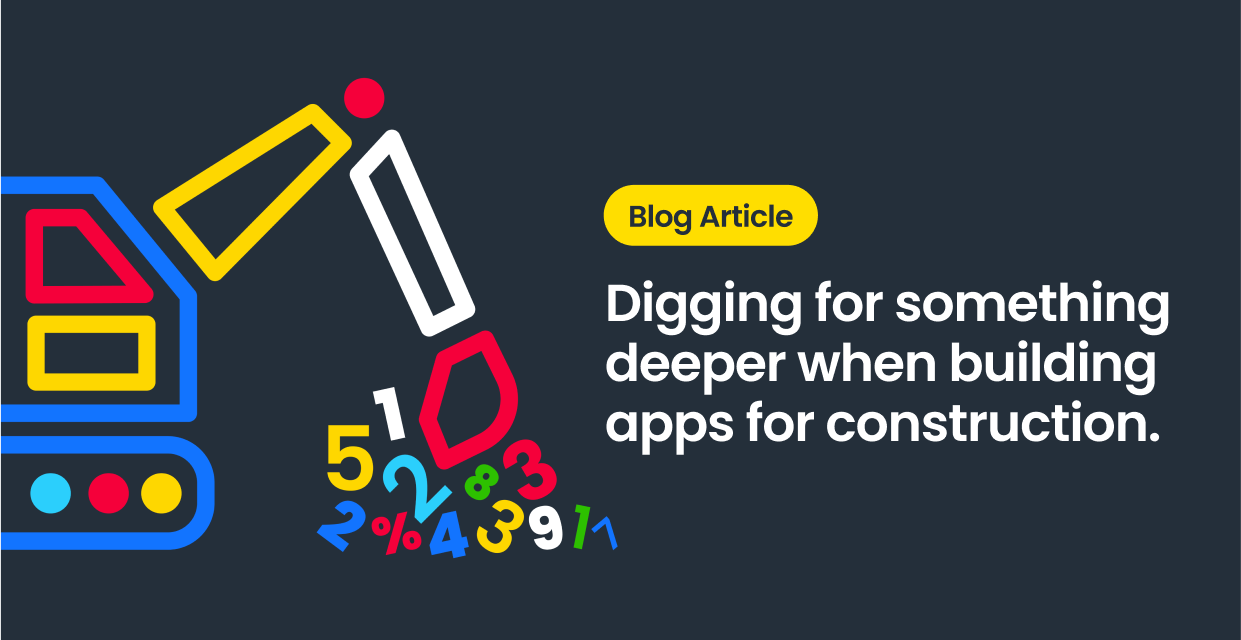Digging for something deeper when building mobile apps for construction

Mobile apps are becoming more prevalent and commonplace in the construction industry and they support more diverse user cases than ever before. So much so, that in an industry connected with primal elements like moving earth and water, it might once have seemed that mobile app technology might not be so fitting. Not now.
On most construction projects from planning to the handover stages, technical software and more recently, mobile apps put efficiency, flexibility and strong data management capabilities in the hands of construction workers. In a report into technology use by construction workers, findings revealed that 92% of the respondents used their smartphone every day at work, with 22% stating that they used 6 or more construction based apps on their devices. ...... and they are being used in a wealth of applications from planning and visualisation, asset management, right through to site and worker safety tools. For those groundbreaking and forward thinking construction experts, the mobile app has become essential for creating and managing the built environment.
In many cases these apps are built bespoke and are customised to suit specific needs or to serve a certain task, and the prevalence of mobile devices is now putting the power to carry out those tasks in worker’s hands within the most remotest and challenging of environments.
But how do those that commission and promote the implementation of a mobile application within their organisation, truly know that users are engaging with it and to its fullest potential?
App downloads are nice, but users are better!
Download statistics will show that users have downloaded the application, and login statistics will show that those that downloaded the application have registered and logged in. So that tells us everything we need, right?
Well, in the same way mobile applications are often used in construction to evidence tasks carried out as required, so we need the evidence and proof of user engagement and app usage. Relying on download statistics is really like a vanity analytic, it’s likely to be a bigger number that looks good on reports but in reality it tells you very little about an app's real usage.
Even tracking users that log in can be of limited value, especially if we don’t know more about what happens within the sessions.
Picture this
Let’s say in the example of a Health and Safety App concerned with worker safety on a construction site that a button exists to log an occurrence and at the end another button allows uploading a photo to evidence what is being reported. In such a case, clicking one button but not the other would be classed as a photo-less report, the user recorded an occurrence but didn’t supply a photo.
The app owner would want to quantify photo-less reports as well as the successful ones they received. WHY? Because, firstly if photos are essential to the function of the app as expected or needed, then if that photo-less report number grows it is essentially showing the number of times the app was not used as prescribed or expected and knowing this could influence remedial action - such as a simple popup warning to confirm that photo upload is necessary.
While this case is admittedly simplistic, it does demonstrate that digging deeper into the usage of apps and what the user does and does NOT DO, is more than just useful to mobile app owners, it brings meaning and can facilitate strategy.
Engineering for Analysis
When a construction client details and specifies the business needs a proposed mobile app should satisfy, mobile app developers like us will have one eye on the value and structure of tracking user behaviours not necessarily connected with the expected functionality of the app. Our industry awareness and experience will enable us to put this into the very foundations of the app development process. What this means for mobile app owners in the construction industry is that with such engineering for analysis in their apps, they can generate reports and enrich their business operations from the key events captured on every page, button and element of their app.
Once known and captured this data can inform strategy, new features, app notifications and email strategies to grow users from the earliest phases and prove the business case blueprint that started the scheme in the first place.
If you want to know more about mobile applications or how to dig for more with mobile analytics in your construction app, click here to send us a message on our contact page.